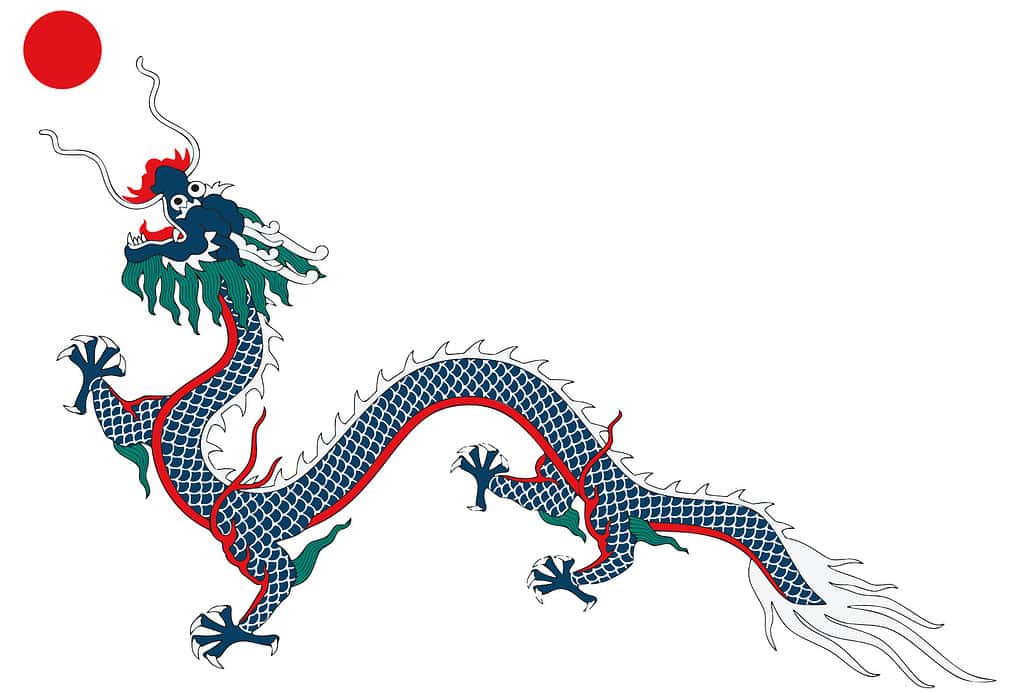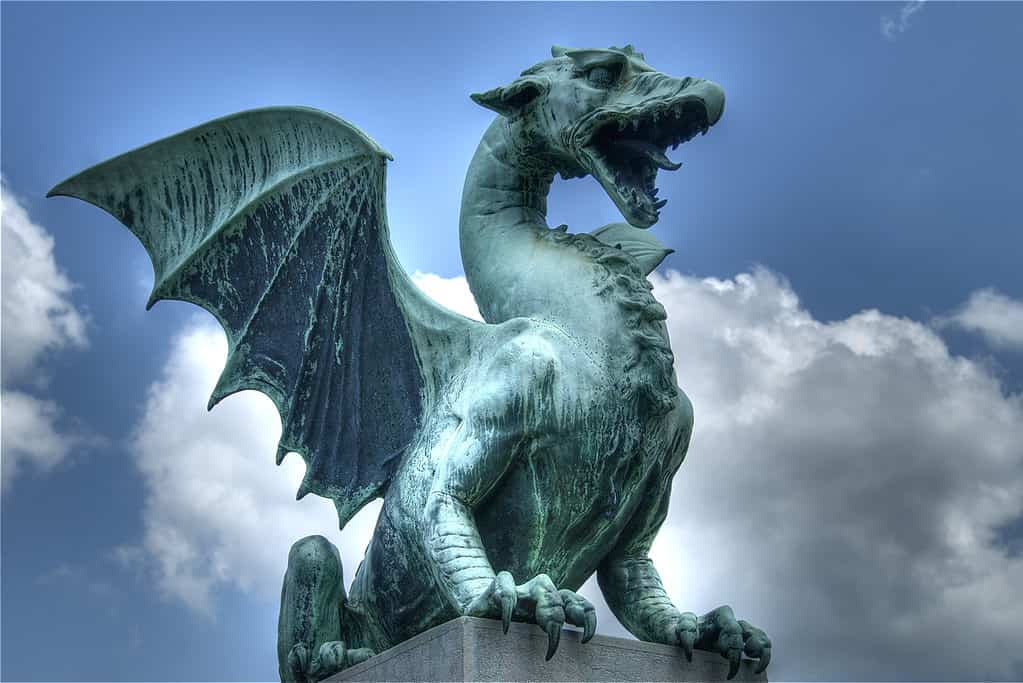Dragons have captured our fascination for centuries and are still going strong. Gracing the big screen are cute dragons like those in How to Train Your Dragon and Pete’s Dragon, lovely ones like those in Raya and the Last Dragon and The Neverending Story, and then there are the scary dragons that we’ve met in Dragon Fury. One thing remains the same: year after year and century after century, we are obsessed with dragons. The history of dragons in different cultures gives the power of good storytelling and imagination worldwide. Each culture views dragons a bit differently. Let’s find out how.
What is a Dragon?

Dragons are good luck in some cultures.
Dragons can take on many forms in different stories, movies, and cultures. Typically, a dragon is a large, scale-covered beast reminiscent of a large lizard with sharp teeth, long claws, long whipping tails, and wings. Dragons breathe fire and can be found in the water or sky. Depending on the culture, dragons may be fierce or calm. Some dragons are evil, while others bring good luck.
Dragons in Folklore and Mythology Around the World

Statue of a dragon guarding one of the beautiful bridges in downtown Ljubljana, Slovenia.
Below are some of the cultures and their ideas of what dragons are and what they mean to them. Dragons are beautiful and frightening creatures, but humans were afraid of most things until they figured them out. Some people even have the dragon as their spirit animal.
Albanian
In Albanian culture, the kulshedra or kuçedra was a dragon of fire, water, and storm but was a Chthonic demon. The kulshedra was a female seven-headed monster. The northern regions believed she could capture the sun and moon, while the southern regions believed she was a weather demon that required human sacrifices. The first stage of kulshedra is a bolla, which is a large water serpent. She keeps her eyes shut every day except Saint George’s Day. If she sees a human on this day, she will eat them. If she remains there for many years, unseen, she will become a kulshedra.
African
There are several different dragons in African folklore, depending on what area of Africa you’re in. The Ninki Nanka is of West African descent. It is described as a huge serpent with reflective scales, wings, and a feathery head crest. Others describe it as having the body of a hippopotamus and the head of a crocodile or giraffe. It was roughly 164 feet long, and seeing one means you will die or have a serious illness.
Chinese
In China, the story of the majestic Long describes a water deity that dwells in oceans, lakes, and rivers and also roams the sky. People held celebrations to honor the Long in the hopes of good fortune. It was described as a serpent-like animal with horns, claws, and four legs. They were a sacred symbol used by emperors.
British
There are many tales about dragons in Europe. The dragons have a similar physique that depicts a huge scaled monster with bat-like wings, four clawed feet, sharp teeth, and long serpent-like tails. They tend to steal women and children, eat villagers, and breathe fire. The dragons must all be fought by brave knights who then offer the dead dragon to a maiden to show their love. This form of dragon is the most widely used in storytelling and cinema. There is another form that British-European dragons held, which was that of a wyvern, a long, serpent-like body and head.
Greek
Many dragons have also come from the Greeks. The word dragon comes from the Greek word drakōn. The drakōn were similar to massive serpents who breathed poison, but not fire, like the western dragons. There is also drakaina, which is the female form of the drakōn. These female dragons were treated somewhat differently and typically survived by mating with a knight.
Japanese
A Japanese dragon, Ryu or Tatsu, was said to be the ancestor of the first Japanese emperor. It is a serpent-like creature without wings. Watatsumi, also called Ryujin or Ryu, was a powerful king dragon who ruled over the sea. He has a large mustache and welcomes all shipwrecked people into his kingdom. In Japan, the dragon is a symbol of power and strength and not to be feared like in Western cultures. The dragon is also a protector of Buddism and is often in Buddist paintings and drawings.
Dragons may be fierce or calm, and some bring rain or good fortune. One evil dragon in folklore is Yamata no Orochi or Orochi. Orochi was a dragon with eight tails and eight heads. Each head represented water, earth, wind, fire, lightning, light, darkness and venom. Its long body stretched over eight hills and mountains. The dragon ate one young girl per year, according to legend.
Mesoamerican
There are many legends about dragons in Mesoamerican. The legends come from Aztec, Toltec, or Mayan myths and are still a topic of discussion today. Some of the Mayan dragons were Kukulkan and Chac. Chac required blood sacrifices in order to make it rain. He had a long nose, the whiskers of a catfish, fish scales, the large ears of a deer, and the head of a crocodile. He could make it lightening by holding up his ax. Kukulkan was actually the Aztec’s feathered serpent god, known as Quetzalcoatl, but was also used by the Mayans. This serpent god did not require sacrifices. He was a god of many things and did a lot of good for the people. He also created the Mayan calendar.
Middle Eastern
Drogs in Middle Eastern cultures depict a large serpent with unimaginable strength. These huge beasts sometimes also had the features of animals with talons, like an eagle or the head of a lion. Some others were sea creatures capable of extreme evil. Others were symbols of Marduk, the supreme god of Babylon.
In Sumeria, which is now central Iraq, one dragon made a name for itself as the first known dragon story. The dragon is evil and looks similar to a serpent. Another dragon from the area was the Goddess Tiamat and her host of dragons. When she was slain, her body was used to create the universe.
Norse
The Scandinavian, or Norse folklore, is overflowing with stories of dragons. The most popular was the dragon Fafnir. Unfortunately, the dragons in this region didn’t mean luck but were more for slaying. In Old Norse, ormr were serpent-like dragons. The terms dreki or draki also mean dragon. Nidhogg is one of the most famous Old Norse dragons, and he spends his time chewing on the Yggdrasil’s roots. Clearly, not a nice guy! Jormungandr, the son of Loki, is another well-known Norse dragon. He is literally a monster who wraps himself across the globe and holds his tail in his mouth. If he releases his tail, he will rise from the ocean and flood the entire world.
Swiss Alpine
Deep within the Swiss Alps, the dragon Stollenwurm or Tatzelwurm lives. It has the face of a cat, the body of a serpent, and two front limbs with claws. They eat livestock and will roll around on the ground with them until they perish. Other Alpine countries have different depictions of the dragon. The dragon makes a high-pitched sound and emits poisonous gases. They tend to live in tunnels, caves, crumbling walls, or abandoned houses.
Final Thoughts

Dragons are one of the strongest characters in stories, myths, and folklore, each with a touch of uniqueness.
©iStock.com/Warpaintcobra
There are many more countries and dragon myths not even touched on in this article. Each country has its own set of folklore and myths that include dragons. Numerous books on such folklore are available and offer a much deeper insight into the lives of dragons in our world. Dragons are amazing, and their stories are some of the best out there. We highly recommend checking out some dragon folklore, legend, and mythology books from your local library. Perhaps, if you’re lucky, you might have a visit by a luck dragon in your dreams tonight. In the meantime, learn about all of the awesome sea, land, and sky dragons that we are lucky enough to share the earth with right here on A-Z Animals.
Thank you for reading! Have some feedback for us? Contact the AZ Animals editorial team.








